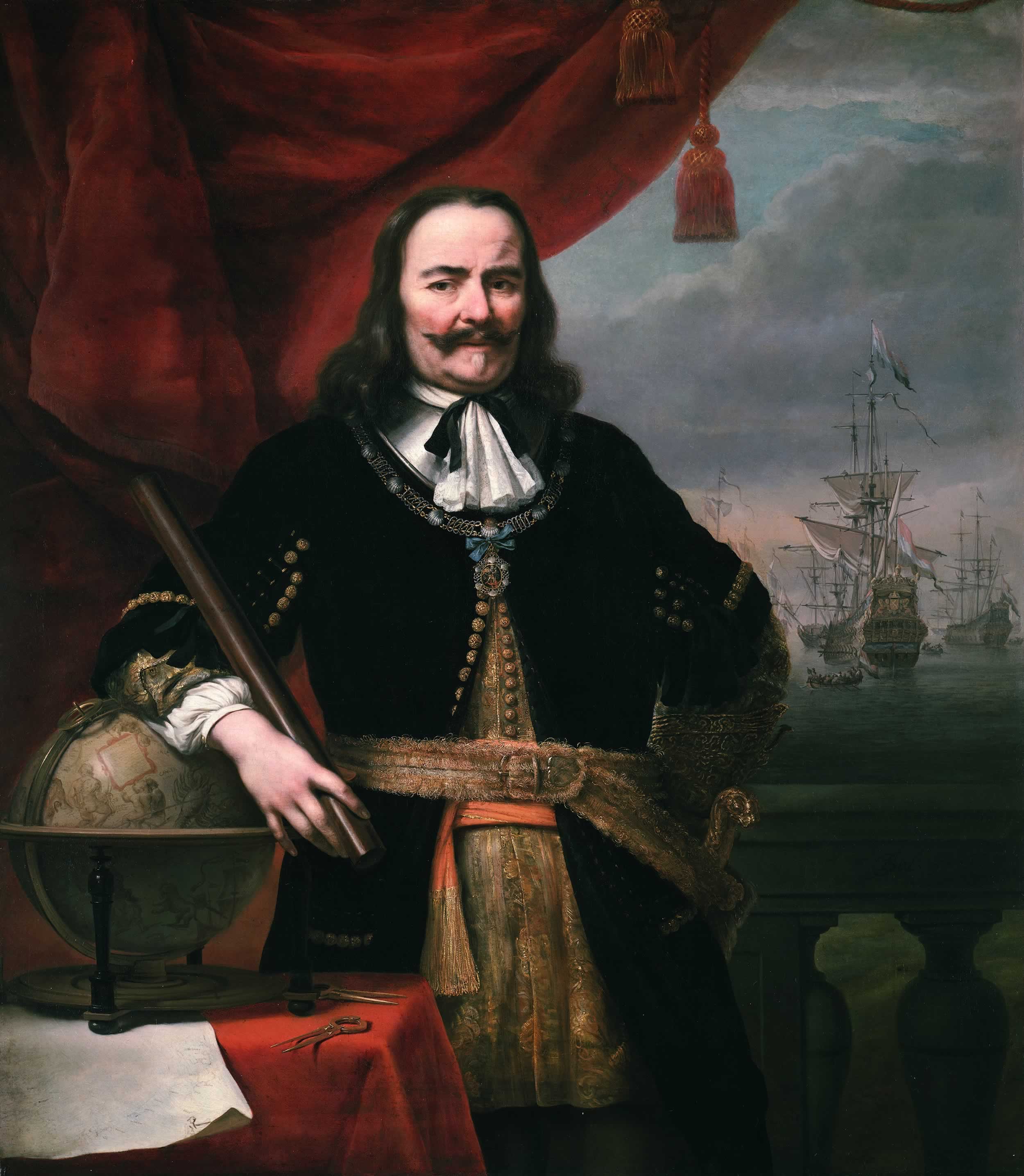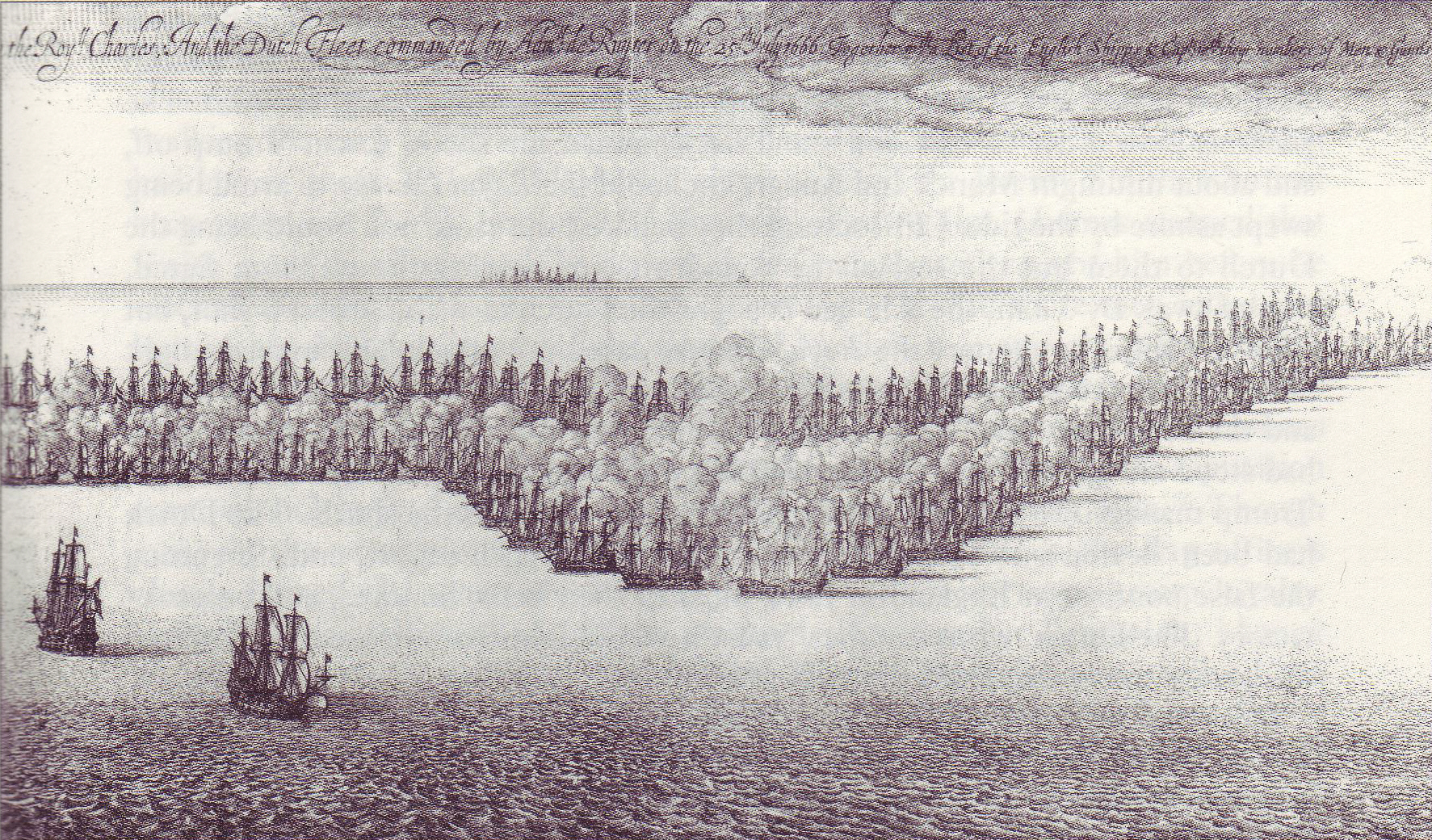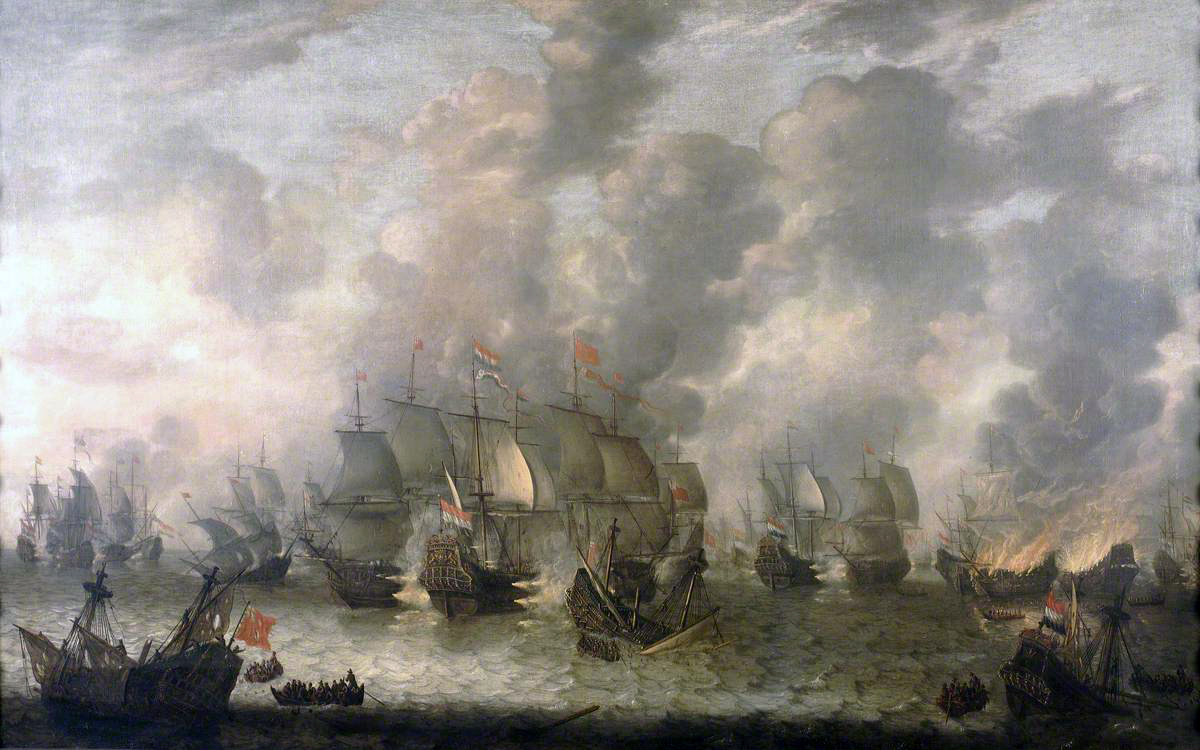|
HMS President (1650)
HMS ''President'' was a 34-gun fourth-rate of the English Navy, built by Peter Pett I at Deptford Dockyard and launched in 1650. She was incorporated into the Commonwealth Navy in 1650. She partook in the Battle off Dover and Kentish Knock in 1652, the Battle of Portland, the Gabbard and Scheveningen in 1653. She was renamed ''Bonaventure'' in 1660. After the Restoration she was incorporated into the Royal Navy. She was present at the Battle of Lowestoft (1665), the Four Days Battle and the Oxfordness in 1666. She was rebuilt in 1666. She was present at the Battle of Martinique in 1667, Battle of Solebay (1672), Battle of Schooneveld and Texel in 1673, the Battle of Beachy Head in 1690, the Battle of Barfleur 1692. ''President'' was the second named vessel since it was used for a 26-gun ship, purchased in 1645 and sold in 1656. Known as ''Old President from 1650. ''Bonaventure'' was the fourth named vessel since it was used for a warship built in 1489 and gone by 1509. Constr ... [...More Info...] [...Related Items...] OR: [Wikipedia] [Google] [Baidu] |
Commonwealth Of England
The Commonwealth was the political structure during the period from 1649 to 1660 when England and Wales, later along with Ireland and Scotland, were governed as a republic after the end of the Second English Civil War and the trial and execution of Charles I. The republic's existence was declared through "An Act declaring England to be a Commonwealth", adopted by the Rump Parliament on 19 May 1649. Power in the early Commonwealth was vested primarily in the Parliament and a Council of State. During the period, fighting continued, particularly in Ireland and Scotland, between the parliamentary forces and those opposed to them, in the Cromwellian conquest of Ireland and the Anglo-Scottish war of 1650–1652. In 1653, after dissolution of the Rump Parliament, the Army Council adopted the Instrument of Government which made Oliver Cromwell Lord Protector of a united "Commonwealth of England, Scotland and Ireland", inaugurating the period now usually known as the Protecto ... [...More Info...] [...Related Items...] OR: [Wikipedia] [Google] [Baidu] |
Battle Of Goodwin Sands
Battle of the Goodwin Sands may refer to: * Battle of the Narrow Seas The Battle of the Narrow Seas, also known as the Battle of the Goodwin Sands or Battle of the Dover Straits was a naval engagement that took place on 3–4 October 1602 during the Anglo-Spanish War of 1585 and part of the Dutch Revolt. An Engl ..., also known as Battle of the Goodwin Sands, 3–4 October 1602, in the Anglo-Spanish War (1585–1604) * Battle of Dover (1652), also known as Battle of the Goodwin Sands, 19 May 1652, opening action of the First Anglo-Dutch War {{set index ... [...More Info...] [...Related Items...] OR: [Wikipedia] [Google] [Baidu] |
Ships Of The Line Of The Royal Navy
A ship is a large watercraft that travels the world's oceans and other sufficiently deep waterways, carrying cargo or passengers, or in support of specialized missions, such as defense, research, and fishing. Ships are generally distinguished from boats, based on size, shape, load capacity, and purpose. Ships have supported exploration, trade, warfare, migration, colonization, and science. After the 15th century, new crops that had come from and to the Americas via the European seafarers significantly contributed to world population growth. Ship transport is responsible for the largest portion of world commerce. The word ''ship'' has meant, depending on the era and the context, either just a large vessel or specifically a ship-rigged sailing ship with three or more masts, each of which is square-rigged. As of 2016, there were more than 49,000 merchant ships, totaling almost 1.8 billion dead weight tons. Of these 28% were oil tankers, 43% were bulk carriers, and 13% were con ... [...More Info...] [...Related Items...] OR: [Wikipedia] [Google] [Baidu] |
Battle Of Texel
The naval Battle of Texel or Battle of Kijkduin took place off the southern coast of island of Texel on 21 August 1673 (11 August Old Style, O.S.) between the Dutch Republic, Dutch and the combined Kingdom of England, English and Kingdom of France, French fleets. It was the last major battle of the Third Anglo-Dutch War, which was itself part of the Franco-Dutch War (1672–1678), during which Louis XIV of France invaded the Republic and sought to establish control over the Spanish Netherlands. English involvement came about because of the Treaty of Dover, secretly concluded by Charles II of England, and which was highly unpopular with the English Parliament. The overall commanders of the English and Dutch military forces were Lord High Admiral James, James II of England, Duke of York, later James II, and Admiral-General William III of England, William III of Orange, his son-in-law and another future King of England. Neither of them took part in the fight. Prince Rupert of the ... [...More Info...] [...Related Items...] OR: [Wikipedia] [Google] [Baidu] |
Battle Of Schooneveld
The Battles of Schooneveld were two naval battles of the Franco-Dutch War, fought off the coast of the Netherlands on 7 June and 14 June 1673 (New Style; 28 May and 4 June in the Julian calendar then in use in England) between an allied Anglo-French fleet commanded by Prince Rupert of the Rhine on his flagship the Royal Charles, and the fleet of the United Provinces, commanded by Michiel de Ruyter. The Dutch victories in the two battles, and at the Battle of the Texel that followed in August, saved their country from an Anglo-French invasion. Background The Franco-Dutch War of 1672–1678 resulted from the attempts of Louis XIV of France to annex the Spanish Netherlands. In 1672, troops from France, Münster and Cologne invaded the Netherlands by land, while England's navy attacked Dutch shipping and threatened a seaborne invasion. The conflict between England and the Republic is commonly called the Third Anglo-Dutch War. The years 1672-1673 were particularly despera ... [...More Info...] [...Related Items...] OR: [Wikipedia] [Google] [Baidu] |
Battle Of Orfordness
St James' Day Battle (also known as St James' Day Fight, the Battle of the North Foreland and the Battle of Orfordness) took place on 25 July 1666 — St James' day in the Julian calendar then in use in England (4 August 1666 in the Gregorian calendar), during the Second Anglo-Dutch War. It was fought between fleets of England, commanded jointly by Prince Rupert of the Rhine and George Monck, 1st Duke of Albemarle, and the United Provinces commanded by Lieutenant-Admiral Michiel de Ruyter. In the Netherlands, the battle is known as the Two Days' Battle. Background This attack followed on the heels of the Four Days' Battle of 1–4 June 1666 which is normally considered a Dutch victory. Battle First day In the early morning of 25 July, the Dutch fleet of 88 ships discovered the English fleet of 89 ships near North Foreland, sailing to the north. De Ruyter gave orders for a chase and the Dutch fleet pursued the English from the southeast in a leeward position, as the wind ... [...More Info...] [...Related Items...] OR: [Wikipedia] [Google] [Baidu] |
Battle Of The Galloper Sand
A battle is an occurrence of combat in warfare between opposing military units of any number or size. A war usually consists of multiple battles. In general, a battle is a military engagement that is well defined in duration, area, and force commitment. An engagement with only limited commitment between the forces and without decisive results is sometimes called a skirmish. The word "battle" can also be used infrequently to refer to an entire operational campaign, although this usage greatly diverges from its conventional or customary meaning. Generally, the word "battle" is used for such campaigns if referring to a protracted combat encounter in which either one or both of the combatants had the same methods, resources, and strategic objectives throughout the encounter. Some prominent examples of this would be the Battle of the Atlantic, Battle of Britain, and Battle of Stalingrad, all in World War II. Wars and military campaigns are guided by military strategy, whereas bat ... [...More Info...] [...Related Items...] OR: [Wikipedia] [Google] [Baidu] |
Battle Of Vagen
A battle is an occurrence of combat in warfare between opposing military units of any number or size. A war usually consists of multiple battles. In general, a battle is a military engagement that is well defined in duration, area, and force commitment. An engagement with only limited commitment between the forces and without decisive results is sometimes called a skirmish. The word "battle" can also be used infrequently to refer to an entire operational campaign, although this usage greatly diverges from its conventional or customary meaning. Generally, the word "battle" is used for such campaigns if referring to a protracted combat encounter in which either one or both of the combatants had the same methods, resources, and strategic objectives throughout the encounter. Some prominent examples of this would be the Battle of the Atlantic, Battle of Britain, and Battle of Stalingrad, all in World War II. Wars and military campaigns are guided by military strategy, whereas bat ... [...More Info...] [...Related Items...] OR: [Wikipedia] [Google] [Baidu] |
Battle Of Scheveningen
The Battle of Scheveningen (also known as the Battle of Ter Heijde) was the final naval battle of the First Anglo-Dutch War. It took place on 31 July 1653 (10 August on the Gregorian calendar), between the fleets of the Commonwealth of England and the United Provinces. The Dutch fleet suffered massive losses but achieved its immediate strategic goal of raising the Royal Navy blockade of the Dutch coast. Background After their victory at the Battle of the Gabbard in June 1653, the English fleet of 120 ships under General at Sea George Monck on his flagship ''Resolution'' blockaded the Dutch coast, capturing many merchant vessels. Royal Museums Greenwich. The Dutch economy began to collapse, with mass unemployment and a severe economic downturn affecting it. On 24 J ... [...More Info...] [...Related Items...] OR: [Wikipedia] [Google] [Baidu] |
James Peacock (English Navy Officer)
Vice-admiral James Peacock (died 1653) was an English naval officer: first in the Parliamentary Navy during the English Civil War, afterwards in the Commonwealth Navy during the First Anglo-Dutch War. Life English Civil War James Peacock appears to have been a merchant and sea captain, whose native place was Ipswich. He is first mentioned as captain of the ''Warwick'' frigate for the Parliament, and commanding a squadron of ships-of-war in the North Sea in the summer of 1647. In December he was moved into the ''Tiger'', and continued on the same service till December 1649. During this time he made several prizes, apparently Royalist privateers hailing from Jersey or from Ireland; convoyed the trade from Elsinore, and was repeatedly warned to station vessels near the Orkney Islands, to surprise Irish pirates, or on the coast of Norfolk, from Cromer to Lynn, to look out for 'pickaroons', 'pilfering sea-rovers'. In June 1648 he assisted in the Siege of Colchester by blockad ... [...More Info...] [...Related Items...] OR: [Wikipedia] [Google] [Baidu] |
Battle Of The Gabbard
The naval Battle of the Gabbard, also known as the Battle of Gabbard Bank, the Battle of the North Foreland or the Second Battle of Nieuwpoort took place on 2–3 June 1653 (12–13 June 1653 Gregorian calendar). during the First Anglo-Dutch War near the Gabbard shoal off the coast of Suffolk, England between fleets of the Commonwealth of England and the United Provinces. The battle The English fleet had 100 ships commanded by Generals at Sea George Monck and Richard Deane and Admirals John Lawson and William Penn. The Dutch had 98 ships under Lieutenant-Admiral Maarten Tromp and Vice-admiral Witte de With, divided in five squadrons. On 2 June 1653 the Dutch attacked but were beaten back because the English employed line-of-battle tactics, making the Dutch pay a high price for attempting to board. The Dutch fleet, consisting of lighter ships, was severely damaged and lost two ships. On 3 June the English were joined by Admiral Robert Blake, but Tromp decided to try again a di ... [...More Info...] [...Related Items...] OR: [Wikipedia] [Google] [Baidu] |
Battle Of Portland
The naval Battle of Portland, or Three Days' Battle took place during 18–20 February 1653 (28 February – 2 March 1653 (Gregorian calendar)), during the First Anglo-Dutch War, when the fleet of the Commonwealth of England under General at Sea Robert Blake was attacked by a fleet of the Dutch Republic under Lieutenant-Admiral Maarten Tromp escorting merchant shipping through the English Channel. The battle failed to settle supremacy of the English Channel, although both sides claimed victory, and ultimate control over the Channel would only be decided at the Battle of the Gabbard which allowed the English to blockade the Dutch coast until the Battle of Scheveningen, where Admiral Maarten Tromp was killed in a firefight. Background The First Anglo-Dutch War was caused by friction between the two naval powers of the century, competing for strategic supremacy over the world's merchant routes. England and the United Provinces had always been 'natural allies' against the Habsb ... [...More Info...] [...Related Items...] OR: [Wikipedia] [Google] [Baidu] |


_-_The_Second_Battle_of_Schooneveld%2C_4_June_1673_-_BHC0306_-_Royal_Museums_Greenwich.jpg)





